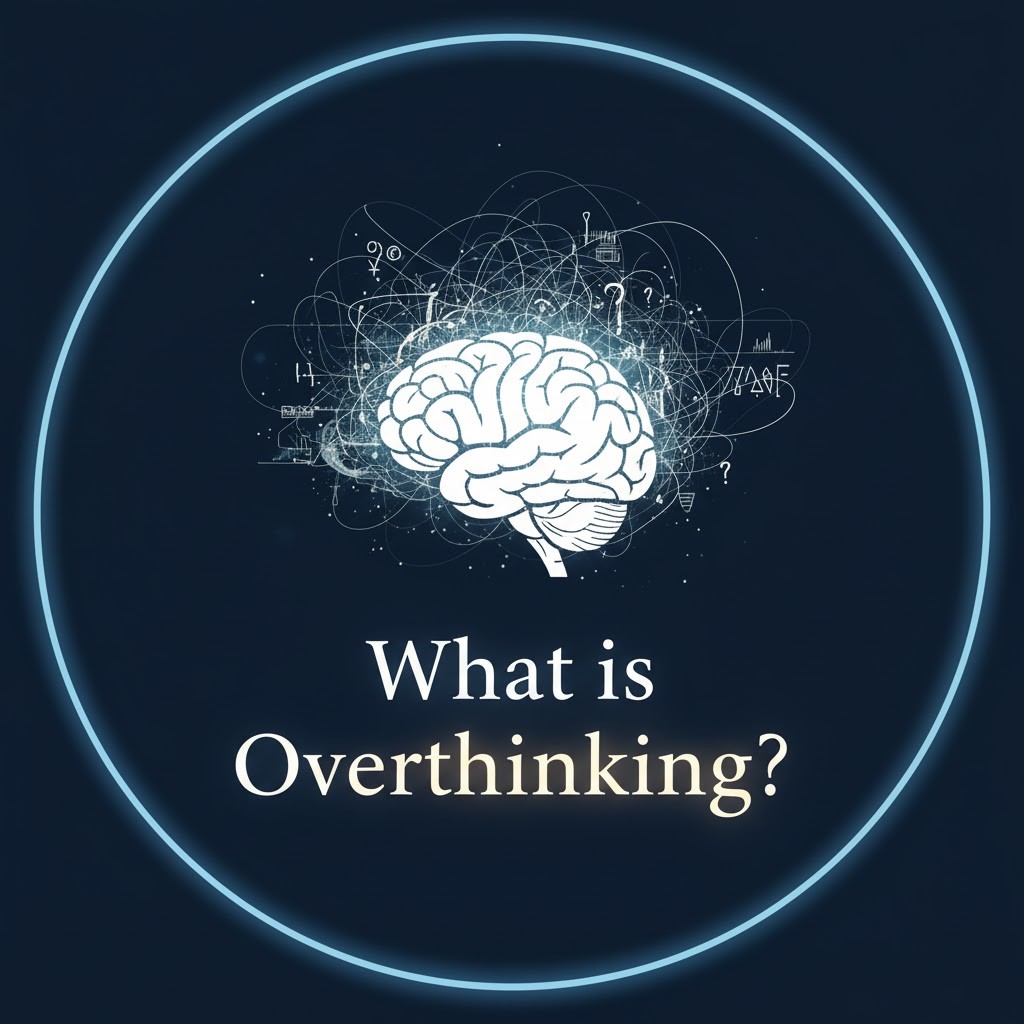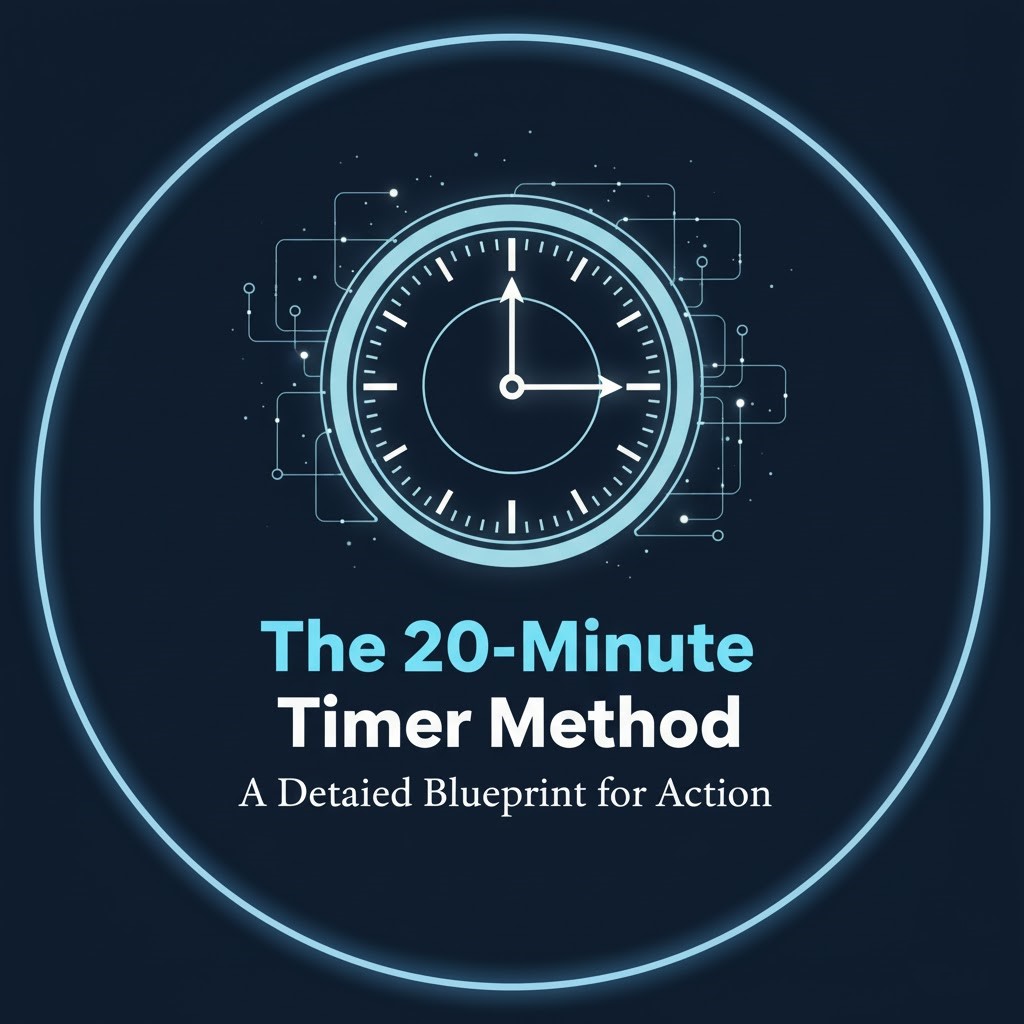Introduction:
We’ve all been there — sitting with a simple decision or task, and suddenly our brain goes into overdrive. Overthinking not only wastes our time but also drains our energy and creativity. One effective method to tackle this is the 20-Minute Timer Technique. This simple yet powerful strategy helps you stop procrastinating and start taking action.

What is Overthinking?
Overthinking is when you spend more time analyzing a task or decision than actually doing it. While reflection can be good, too much of it keeps us stuck in the same loop.
Deconstructing Overthinking: More Than Just Thinking Too Much
To effectively combat overthinking, we must first understand its true nature. Overthinking, or what psychologists often call “rumination,” is more than just being thoughtful. It’s the process of getting stuck in a mental loop of repetitive, unproductive thoughts about a problem or decision. It occurs when the cognitive scales tip, and you invest vastly more time and mental energy in analyzing a task than in executing it.
This pattern often manifests in several ways:
- The Perfectionism Trap: Endlessly rewriting a single sentence, searching for the “perfect” word, or tweaking a design element long after it’s functional.
- The Decision Paralysis: Weighing the pros and cons of every minor choice, from which project to start first to what font to use, until you’re too exhausted to choose anything.
- The Catastrophizing Spiral: Imagining every possible negative outcome—”What if my idea is rejected?” “What if I make a mistake?”—until the perceived risk of acting feels greater than the cost of inaction.
- The Preparation Fallacy: Convincing yourself you need to do “just a little more research” or create “one more detailed outline” before you can possibly begin the actual work.
The most dangerous aspect of overthinking is its clever disguise. It often masquerades as diligence or thoroughness, making us feel like we’re being productive when we are, in fact, merely spinning our mental wheels. This chronic overthinking keeps us trapped in the hesitation phase when we should be moving forward with action, creating a gap between intention and execution that grows wider with every passing minute.

The 20-Minute Timer Method: A Detailed Blueprint for Action
The 20-Minute Timer Method is a form of what productivity experts call “timeboxing.” It’s a structured approach that replaces open-ended effort with a focused, time-constrained burst. Here’s a detailed, step-by-step guide to implementing it correctly:
- Identify and Commit: The first step is to clearly define the task you’ve been avoiding or overthinking. Be specific. Instead of “work on the report,” your task is “draft the introduction for the quarterly report.” Once identified, make a conscious commitment. Tell yourself, “For the next 20 minutes, this is my sole focus.” The specificity of this 20-minute timeframe is crucial—it’s long enough to make meaningful progress but short enough to feel immediately manageable, thereby disarming the anxiety that fuels overthinking.
- Eliminate and Focus: Before starting the timer, create a fortress of focus. This is non-negotiable. Silence your phone, close all unnecessary browser tabs (especially email and social media), and if possible, put a “Do Not Disturb” sign on your door. This pre-ritual signals to your brain that it’s time to enter a different mode. During these 20 minutes, you are a single-tasking machine. This forced focus prevents the scattered, multi-tasking mindset that often derails progress and invites overthinking back in.
- Embrace “Good Enough”: This is the psychological core of the method. Consciously and deliberately release the need for perfection. Give yourself explicit permission to produce work that is messy, imperfect, and unfinished. The goal is not to create a masterpiece in 20 minutes; the goal is to create momentum. Remember, a rough draft written is infinitely more valuable than a perfect draft imagined. Giving yourself permission to be imperfect directly counters the perfectionism that is the primary engine of overthinking.
- Honor the Stop: When the timer rings, you must stop. Even if you’re on a roll. Even if you’re in the middle of a sentence. This is a critical part of the process. Stopping trains your brain to trust the system. It reinforces that the commitment was real and manageable, making it easier to start the next time. It also often has a wonderful side effect: your subconscious mind will continue working on the problem, and you may return with fresh insights and solutions, having broken the cycle of conscious overthinking.
The Psychology of Why It Works: Disarming the Overthinking Mind
The effectiveness of this method isn’t accidental; it’s rooted in solid psychological principles that systematically dismantle the patterns of overthinking.
- It Shrinks the Task: Overthinking often makes mountains out of molehills. The 20-minute frame shrinks the mountain back down to a manageable molehill. Your brain isn’t intimidated by “work for 20 minutes” in the same way it’s terrified of “finish this massive project.”
- It Creates Positive Urgency: Parkinson’s Law states that “work expands to fill the time available for its completion.” A deadline—even a self-imposed one—creates a healthy sense of urgency that overrides the tendency to dawdle and overthink. There simply isn’t time for excessive analysis.
- It Builds Momentum with “The Progress Principle”: Pioneered by Harvard Business School researchers, this principle posits that of all the things that can boost emotions, motivation, and perceptions during a workday, the single most important is making progress in meaningful work. A successful 20-minute sprint provides a concrete, undeniable win. This small victory releases dopamine, making you feel good and building the momentum needed to continue, effectively breaking the negative feedback loop of overthinking.
- It Separates Creation from Criticism: Overthinking often occurs when the creative and critical parts of our brain are active simultaneously. The writer is trying to create, while the inner editor is viciously critiquing every word. The 20-minute rule, especially the “allow imperfection” clause, muzzles the inner critic. It tells that critical voice, “Your turn will come later, but for now, we’re just creating.” This separation is liberating for the creative process.
Advanced Applications and Long-Term Benefits
Once you’ve mastered the basic technique, you can apply it to various forms of overthinking:
- The “Worry Timer”: If you find yourself overthinking a personal problem or anxiety, set a 20-minute timer and dedicate that time solely to thinking about it. Write down every worry. When the timer stops, you must consciously decide to stop actively worrying. This contains the overthinking to a specific period, preventing it from bleeding into your entire day.
- The “Decision Deadline”: For decisions you’re overthinking, give yourself 20 minutes to list options, pros, and cons. When the timer ends, you must make the best decision you can with the information you have. This prevents the endless search for more data that never quite tips the scales.
The long-term benefits extend far beyond a single completed task. Consistently using this method can rewire your brain’s default response to challenging tasks. You begin to associate starting with feelings of accomplishment rather than anxiety. You build a portfolio of evidence that proves you can accomplish more with less deliberation than you thought, fundamentally weakening the power of overthinking in your life. You reclaim not just hours of lost time, but also the mental energy and creative confidence that overthinking once stole from you.
Conclusion: Your Time to Start Is Now
The next time you feel that familiar tug of overthinking—that hesitation, that urge to perfect, that fear of starting—remember that the 20-Minute Timer is a powerful tool waiting in your arsenal. This straightforward technique from BST provides immediate relief from the mental burden of overthinking while delivering tangible, satisfying results.

